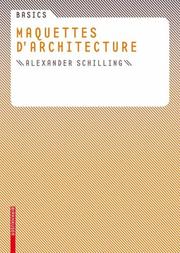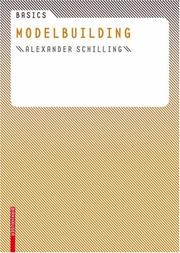| Listing 1 - 10 of 15 | << page >> |
Sort by
|
Book
ISBN: 3035614792 9783035614794 9783035614732 9783035614770 3035614784 Year: 2018 Publisher: Basel
Abstract | Keywords | Export | Availability | Bookmark
 Loading...
Loading...Choose an application
- Reference Manager
- EndNote
- RefWorks (Direct export to RefWorks)
Architectural models are used at various stages of a project. As working models they support the design process: they are made up from time to time using simple materials, such as cardboard, without any attempt at accuracy, and continue to be adjusted and added to as the ideas and the design progress. The point here is to swiftly check a design idea, to allow it to be continued or dismissed. Presentational models are more involved; at this stage the design has been completed and the purpose of the model is to convey the ideas to the potential user in a clear and easy-to-understand way. The book Architecture and Model Building includes outstanding examples explaining the possibilities of this medium and, at the same time, provides comprehensive information on materials and techniques.
Architectural models --- Maquettes (architecture) --- Maquette --- Processus de conception --- Processus de création --- 741:72 --- Architectuur ; maquettes ; schaalmodellen --- Architectuurontwerpen ; maquettes ; technieken --- Buildings --- Models, Architectural --- Architectural casts --- Artists' preparatory studies --- Communication in architectural design --- Miniature objects --- Models and modelmaking --- Tekenkunst ; architectuurtekeningen --- Models --- Bouwmodellen ; architectuurmodellen --- Architecture --- architecture [discipline] --- architectural models

ISBN: 9783764379568 3764379561 Year: 2007 Publisher: Bâle : Birkhäuser - Editions d'architecture,
Abstract | Keywords | Export | Availability | Bookmark
 Loading...
Loading...Choose an application
- Reference Manager
- EndNote
- RefWorks (Direct export to RefWorks)
Dans cette collection de petits manuels didactiques et pratiques, un volume consacré aux représentations à échelle réduite de futurs édifices : les bases et informations pratiques nécessaires à la fabrication des maquettes.
Architectural models. --- Modèles architecturaux --- Manuel --- Maquette --- Conception de projet --- Maquettes (architecture) --- Modèles architecturaux --- Processus de conception

ISBN: 9783764376499 376437649X Year: 2007 Publisher: Basel Birkhäuser
Abstract | Keywords | Export | Availability | Bookmark
 Loading...
Loading...Choose an application
- Reference Manager
- EndNote
- RefWorks (Direct export to RefWorks)
Models make it possible to visualize an idea in three dimensions. Designing with models and presenting ideas is an important step in the development of a consciousness of design. Themes: Levels of abstraction and degrees of detail Model typologies Typical working tools and techniques Materiality of models Presentation possibilities
72.02 --- maquettebouw --- 72.014 --- Maquettes (architectuur) --- Modellen (architectuur) --- Architectuurmaquettes --- Architectuurmodellen --- Presentatietechnieken (architectuur) --- architectuur - maquettebouw, representatie --- Bouwtechniek: methoden en materialen --- Modelbouw --- 72.02 Bouwtechniek: methoden en materialen --- Modelbouw. --- Architectural models --- Buildings --- Models, Architectural --- Architectural casts --- Artists' preparatory studies --- Communication in architectural design --- Miniature objects --- Models and modelmaking --- Models --- Modelbouw ; architectuur.
Book
ISBN: 3035612757 3035612145 9783035612141 9783034613316 3034613318 Year: 2013 Publisher: Basel Birkhäuser
Abstract | Keywords | Export | Availability | Bookmark
 Loading...
Loading...Choose an application
- Reference Manager
- EndNote
- RefWorks (Direct export to RefWorks)
Modelle ermöglichen eine räumliche Vorstellung des Konzeptes. Das Entwerfen am Modell und das Präsentieren von Konzepten ist ein wichtiger Schritt in der Bildung eines Entwurfsbewusstseins. Themen: Abstraktionsgrade und Detailtiefe Modelltypologien Typische Arbeitsmittel und -techniken Materialität von Modellen Präsentationsmöglichkeiten Models make it possible to visualize an idea in three dimensions. Designing with models and presenting ideas is an important step in the development of a consciousness of design. Themes: Levels of abstraction and degrees of detail Model typologies Typical working tools and techniques Materiality of models Presentation possibilities
Architectural models. --- Buildings --- Models, Architectural --- Architectural casts --- Artists' preparatory studies --- Communication in architectural design --- Miniature objects --- Models and modelmaking --- Models --- Architectural models --- 72.02 --- Architectuur ; visuele weergave en voorstellingstechnieken --- Maquettes ; basishandboeken --- Modellen ; maquettes --- Representatietechnieken --- Architectuur ; techniek, werkmethoden, behoud --- 72.021.22 --- 72.021.22 Architectuurtekeningen. Werktekeningen. Reconstructietekeningen --- Architectuurtekeningen. Werktekeningen. Reconstructietekeningen
Book
ISBN: 3035614733 9783035614732 9783035614794 Year: 2018 Publisher: Basel
Abstract | Keywords | Export | Availability | Bookmark
 Loading...
Loading...Choose an application
- Reference Manager
- EndNote
- RefWorks (Direct export to RefWorks)
Architectural models are used at various stages of a project. As working models they support the design process: they are made up from time to time using simple materials, such as cardboard, without any attempt at accuracy, and continue to be adjusted and added to as the ideas and the design progress. The point here is to swiftly check a design idea, to allow it to be continued or dismissed. Presentational models are more involved; at this stage the design has been completed and the purpose of the model is to convey the ideas to the potential user in a clear and easy-to-understand way. The book Architecture and Model Building includes outstanding examples explaining the possibilities of this medium and, at the same time, provides comprehensive information on materials and techniques.
Architectural models. --- Buildings --- Models, Architectural --- Architectural casts --- Artists' preparatory studies --- Communication in architectural design --- Miniature objects --- Models and modelmaking --- Models --- design. --- model building. --- model making. --- presentation.
Book
ISBN: 9783035621860 9783035612493 9783035621952 Year: 2020 Publisher: Basel Birkhäuser
Abstract | Keywords | Export | Availability | Bookmark
 Loading...
Loading...Choose an application
- Reference Manager
- EndNote
- RefWorks (Direct export to RefWorks)
Book
ISBN: 9783035621822 9783035621914 9783035621976 Year: 2020 Publisher: Basel Birkhäuser
Abstract | Keywords | Export | Availability | Bookmark
 Loading...
Loading...Choose an application
- Reference Manager
- EndNote
- RefWorks (Direct export to RefWorks)
Book
ISBN: 3035612498 3035611661 Year: 2017 Publisher: Basel : Birkhäuser,
Abstract | Keywords | Export | Availability | Bookmark
 Loading...
Loading...Choose an application
- Reference Manager
- EndNote
- RefWorks (Direct export to RefWorks)
Modelle ermöglichen eine räumliche Vorstellung des Konzeptes. Das Entwerfen am Modell und das Präsentieren von Konzepten ist ein wichtiger Schritt in der Bildung eines Entwurfsbewusstseins. Themen: Abstraktionsgrade und Detailtiefe Modelltypologien Typische Arbeitsmittel und -techniken Materialität von Modellen Präsentationsmöglichkeiten Models make it possible to visualize an idea in three dimensions. Designing with models and presenting ideas is an important step in the development of a consciousness of design. Themes: Levels of abstraction and degrees of detail Model typologies Typical working tools and techniques Materiality of models Presentation possibilities
Book
ISBN: 9783035612752 Year: 2017 Publisher: Basel
Abstract | Keywords | Export | Availability | Bookmark
 Loading...
Loading...Choose an application
- Reference Manager
- EndNote
- RefWorks (Direct export to RefWorks)
Book
ISBN: 9783515106627 3515106626 Year: 2014 Volume: 2 Publisher: Stuttgart Franz Steiner Verlag
Abstract | Keywords | Export | Availability | Bookmark
 Loading...
Loading...Choose an application
- Reference Manager
- EndNote
- RefWorks (Direct export to RefWorks)
Zu Beginn des 19. Jahrhunderts wurde durch keinen Geringeren als Johann Wolfgang von Goethe eine "Geschichte der drei Könige" (Historia trium regum) wieder entdeckt, die seither dem Karmelitermönch Johannes von Hildesheim (†1375) zugeschrieben wird und eine – früh in zahllose Volkssprachen übersetzte – literarische Summe mittelalterlicher Legenden um die Heiligen Drei Könige darstellt. Eine Analyse der orientalischen Traditionen zu den Magiern der Geburtsgeschichte Jesu nach Matthäus, anhand altfranzösischer, lateinischer, griechischer, armenischer, syrischer, äthiopischer, arabischer, persischer und uigurischer Texte, ermöglicht die Identifikation einer der orientalischen Vorlagen zur lateinischen "Geschichte der drei Könige" – das so genannte "Rollenbuch". Zu Beginn des 13. Jahrhunderts den Kreuzfahrern vor Damiette bekannt geworden, war es wohl eine bislang noch nicht identifizierte Übersetzung dieses "Rollenbuches" in eine europäische Sprache, die den Ausschlag dafür gegeben hat, dass die französischen Grafen von Baux-Luxembourg sich seit dem 15. Jahrhundert als Nachfahren "Balthasars", eines der Heiligen Drei Könige, inszenieren konnten.
| Listing 1 - 10 of 15 | << page >> |
Sort by
|

 Search
Search Feedback
Feedback About UniCat
About UniCat  Help
Help News
News